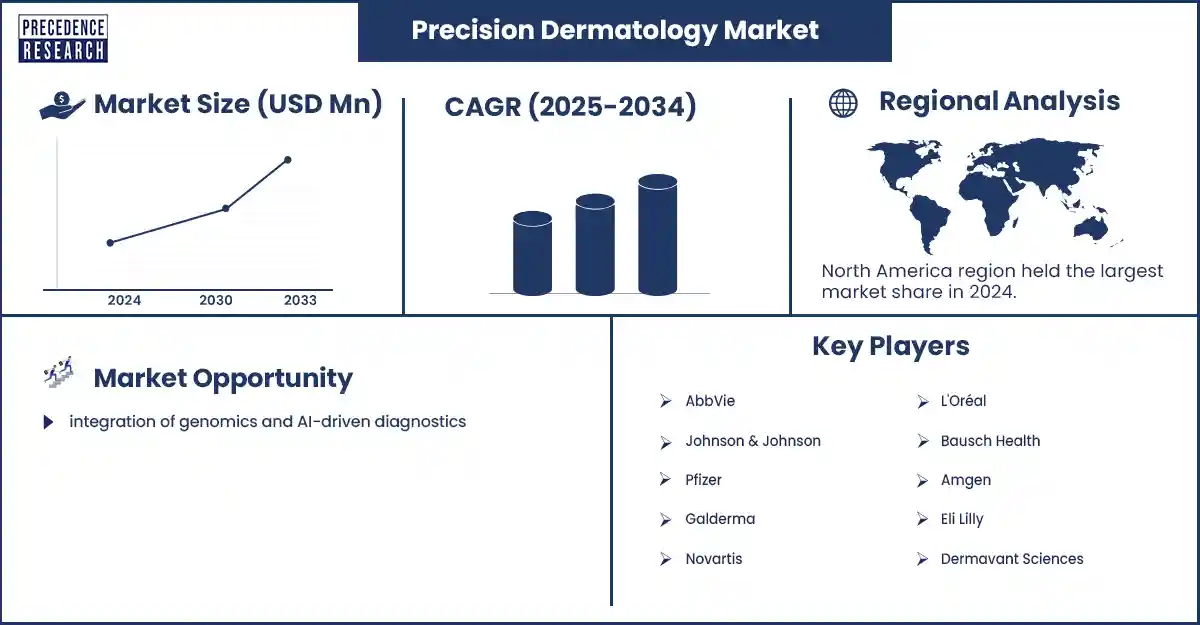Precision Dermatology Market Revenue and Forecast by 2033
Precision Dermatology Market Revenue and Trends 2025 to 2033
Explore how precision medicine is revolutionizing dermatology with data-driven skin diagnostics, tailored therapies, and global investment trends. This market is expanding due to the rising incidence of chronic skin disorders and advances in molecular diagnostics and targeted therapeutics.

What are the key drivers enabling the growth in the precision dermatology market?
The market's growth is driven by multiple factors. The increasing global incidence of complex skin conditions like psoriasis, atopic dermatitis, and alopecia areata is driving demand for more efficient and tailored care options. Advancements in genomics, transcriptomics, and biomarker discovery support the development of companion diagnostics and precision interventions, which minimize trial-and-error prescribing and enhance patient outcomes. Increased healthcare spending, the role of reimbursements in facilitating proof of value in advanced markets, and the increased willingness of patients to pay for enhanced dermatologic care also play a role. The growing use of artificial intelligence and digital skin imaging platforms enhances diagnostic decision-making, supporting clinical acceptance and scaling. Finally, a series of strategic partnerships, mergers, or acquisitions between companies in the biotechnology, diagnostics, and dermatology sectors are accelerating product development and market access.
Segment Insights
- By product & service type, the targeted therapeutics (biologics) segment dominated the market in 2024 due to their high efficacy and specificity in treating complex skin conditions. These biologics offer personalized treatment options with improved outcomes and fewer side effects compared to traditional therapies, driving strong adoption among healthcare providers and patients.
- By application, the inflammatory skin disease (psoriasis) segment dominated the market in 2024 due to the high prevalence and chronic nature of psoriasis, which requires targeted and effective treatment options.
- By technology, the genomic & transcriptomic profiling segment dominated the market in 2024 due to high-throughput sequencing and RNA expression assays, which provide deep insights into disease pathways and facilitate precision therapeutic matching in dermatology.
- By end user, the hospitals & dermatology clinics segment dominated the market with the largest share in 2024, as these settings have the specialized methods and infrastructure necessary to deliver precision diagnostic testing and advanced patient care.
Regional Insights:
North America registered dominance in the precision dermatology market in 2024. This is mainly due to its advanced healthcare infrastructure and significant investment in research and development. The region's favorable regulatory environment, particularly regarding companion diagnostics, has accelerated market growth. The U.S., a major player, boasts high per capita spending on dermatological services and reimbursement for precision testing. This, combined with the presence of leading biotech and dermatology companies, has solidified North America's market leadership.
Asia Pacific is expected to grow at a rapid pace in the market. This growth is fueled by the rising prevalence of skin diseases and improved healthcare access, especially in China, Japan, India, and South Korea. The advancement of molecular diagnostics, a strengthening biotech ecosystem, and government initiatives in genomics and personalized healthcare are key drivers. These factors collectively contribute to the APAC region's rapid expansion compared to other regions.
Precision Dermatology Market Coverage
| Report Attribute | Key Statistics |
| Quantitative Units | Revenue in USD million/billion, Volume in units |
| Largest Market | Asia Pacific |
| Base Year | 2024 |
| Regions Covered | North America, Europe, Asia-Pacific, Latin America, and the Middle East & Africa |
Recent Development
- In April 2025, Molecular Instruments® (MI), in collaboration with Yale’s Dermatology Department, developed novel lab-developed tests (LDTs) using its HCR™ Pro RNA-ISH technology and a four-biomarker panel to improve diagnostic accuracy and treatment guidance for psoriasis and atopic dermatitis. (Source- https://www.livderm.org)
Get this report to explore global market size, share, CAGR, and trends, featuring detailed segmental analysis and an insightful competitive landscape overview @ https://www.precedenceresearch.com/sample/6995
You can place an order or ask any questions, please feel free to contact us at sales@precedenceresearch.com |+1 804 441 9344